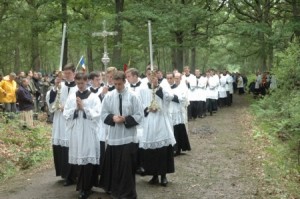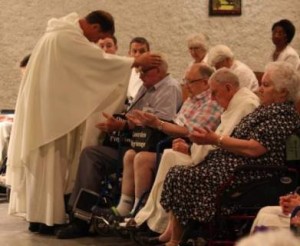“He did not know what to say, for they were exceedingly afraid [Mark 9: 5].” With this little detail, Saint Mark reveals quite a bit about the character of Saint Peter and the human condition in general. Under normal circumstances, we are unprepared to behold the full glory of God, and when suddenly God’s grandeur “flame[s] out, like shining from shook foil,” it can be a terrifying, disorienting experience.
We have many testimonies of this encounter. One early, telling encounter was that of the prophet Isaiah. Isaiah was a priest and probably had entered God’s temple countless times to offer sacrifice. One day, he suddenly saw in reality what he had been celebrating in shadowy, symbolic ways. “I saw the Lord sitting upon a throne, high and lifted up….And I said, “Woe is me! For I am lost; for I am a man of unclean lips…for my eyes have seen the King, the LORD of hosts [Isaiah 6: 1, 5]!” Isaiah is rendered voluntarily speechless until his lips are cleansed by a coal from the altar.
Similarly, Saint Thomas Aquinas, toward the end of his earthly life, was celebrating the Eucharist as he had many times before. This time was different. Like Isaiah, he glimpsed something of the reality that he had celebrated in the half-veil of sacramental mystery. The author of the Summa Theologica, perhaps the greatest intellectual achievement of all time, wrote no more after this, leaving the Summa unfinished. “All that I have written seems as so much straw,” he confided to a friend.
Saint Peter suffers no such scruples. Beholding Christ transfigured, he was properly afraid. Not knowing what to say, however, he said whatever came to mind. In this, he seems to be of a kindred mindset to modern man. Is it not the case that our incessant talking, the swarming proliferation of words, is so much nervous chatter to cover over our anxiety and alienation? We hardly know what to say, yet we can’t stop talking. In our case, I suspect that silence doesn’t occur to us because our fear is not the result of an encounter with the living God, but with the dreadful possibility of His utter absence.
I began by saying that we are not normally prepared to meet God in the unmitigated power of His limitless Being. What the Transfiguration begins to teach us is that, under the dispensation of grace, in the afterglow of the Resurrection and Pentecost, we live under a “new normal.” We live in the in-between time, the time of the holy Liturgy, after the shadows of animal sacrifice but not yet at the full consummation of the world. The Kingdom of God is breaking into the world that itself is passing away. The baptized, as God’s adopted children, are being trained to “see [God] as He is [1 John 3: 2].” The training of our senses and their elevation to the spiritual realm takes place in the liturgy.
This past June, we were blessed to be able to unveil our two newest icons, the Archangels Michael and Gabriel, flanking the Mother of God and John the Baptist. Gradually, our sanctuary is being populated with the communion of the saints. Icons are not mere representations of model believers. The iconographer truly receives the image from the inbreaking realm of heaven. Iconography is, therefore, an ascetical craft, a discipline of visual listening and receptivity, a training of the interior vision to see beyond the sacramental into the reality of God’s holy court. At the same time, icons train the worshipper to attune his or her senses to this new reality. The icons are a central part of the liturgical act, and as conduits of grace, help to elevate the sense of sight to its proper spiritual register.
Similarly, sacred music is much more than pleasing ornamentation of holy words. As Kevin Allen and I have discussed at various time in our decade of collaboration, the composer of sacred music must, like the iconographer, exercise a discipline of spiritual listening. The aim is, through purification of hearing, to catch something of the overwhelming beauty of the perpetual song of heaven. At Solemn Vespers this coming Saturday evening (August 5, 5:15 p.m.), the First Vespers of the feast of the Transfiguration, Kevin and I humbly offer two new motets in this spirit. We pray that our double motet will be a similar conduit of grace, to prepare our hearts to hear God’s Word in its fullest transformative power.

